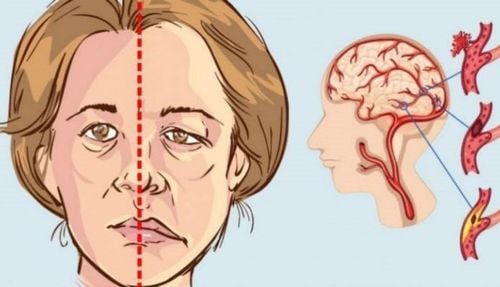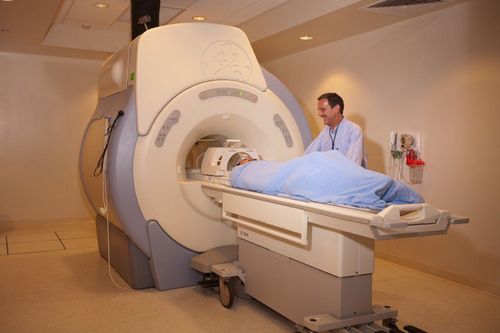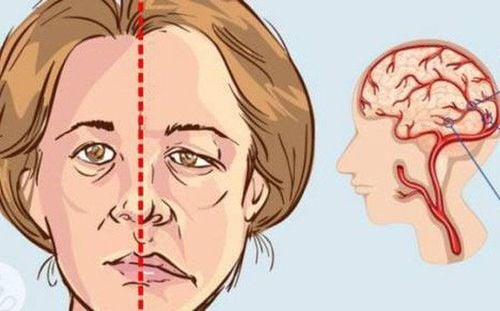This is an automatically translated article.
The article is expertly consulted by Master, Doctor Huynh An Thien - Department of Medical Examination & Internal Medicine, Vinmec International Hospital Da Nang.Cerebrovascular accident is a very urgent condition that needs to be handled immediately, if it is too "golden time" it can lead to dangerous complications and death. Here are 10 signs of a cerebrovascular accident that everyone needs to know for timely handling.
1. How dangerous is a cerebrovascular accident?
Cerebrovascular accident is a phenomenon in which the brain is not supplied with enough blood, leading to a lack of oxygen and nutrients. If within a few minutes, brain blood is not circulated, it will cause brain cells to die. The larger the damaged brain area, the more severe the damage is, the more sequelae will be left, possibly even leading to death.Cerebrovascular accident has two types: cerebral hemorrhage and cerebral infarction. In case of cerebral haemorrhagic stroke, it is necessary to be taken to the emergency hospital within minutes, while the case of cerebral infarction can be treated within 4-5 hours after the occurrence of the stroke, but should be taken to the hospital. Patients go to the hospital as soon as possible, the sooner the emergency treatment, the less the possibility of sequelae.
The number of people dying from cerebrovascular accidents is increasing day by day. This is the biggest cause of disability, paralysis and is in the top 3 leading causes of death in the world.
2. 10 signs of cerebrovascular accident
2.1. Sad face, one side distorted
Signs of a stroke are shown on the patient's face before the accident occurs. The amount of oxygen in the blood supply to the brain gradually decreased, causing nerve damage affecting the facial muscles. The patient's face becomes sad, part or half of the face is paralyzed, unable to move.If you suspect that the patient is about to have a stroke, ask the patient to smile, if the smile is partially concave, one side of the face drooping, that is a sign of a stroke.

2.2. Decreased arm mobility
Insufficient blood flow to the brain causes reduced mobility, especially the arms. The patient will feel the arm numb, difficult to move and then gradually unable to move. Signs of stroke in the arm are most easily detected when you ask the patient to raise his arms high, one arm will not be able to raise or hang down.2.3. Decreased eyesight
Decreased vision is a sign of a stroke that is difficult for outsiders to detect. Therefore, patients need to actively remember these signs of complications and immediately notify family members when there is an abnormality. The cause is that the lobe of the brain responsible for vision is not supplied with enough oxygen, the activity of the brain lobe gradually decreases, causing vision to be affected. The patient will see everything blur, fade.2.4. Stutter
Before a stroke occurs, blood clots block the flow of blood to the part of the brain that controls communication and speech. Therefore, the patient will have signs of stuttering, not being able to speak long sentences, not speaking clearly, and difficult to understand.2.5. Part of the body is weak, unable to move
After being paralyzed in an arm, a person can experience paralysis of part of the body, even half of the body. Some moving parts are difficult or even though they try to control them, they can't move. This is a very dangerous sign, which can lead to permanent paralysis if not taken medicine or taken to the hospital in time.2.6. Dizziness
Dizziness, dizziness, lightheadedness are manifestations of cerebral ischemia. This is a very common sign of a stroke, occurring in most cases.2.7. Unusual gait
The next sign of complications that the patient may experience is being unable to walk or having difficulty walking. If the patient was walking normally before, surely the amount of blood to the brain is decreasing rapidly. If the patient has had difficulty moving before, it is important to monitor closely to see if the effect is increasing.
2.8. Headache
Lack of oxygen to the brain will cause the patient to feel a severe headache, intermittent pain. Some patients even feel like their head will explode. The pain is getting more and more intense. If you experience this sign, you need to take the patient to the hospital immediately, otherwise it will likely lead to brain death complications.2.9. Hiccup
One of the early warning signs of a stroke that few people realize is hiccups. Many people suddenly have hiccups thinking that it is just normal hiccups, leading to subjective. This phenomenon is common in women.2.10. Shortness of breath
Patients may find it difficult to breathe, gasp, and heart palpitations. Each person may have some of the above signs of stroke, depending on the area of the brain affected by lack of oxygen. The above symptoms occur in a very short time and can disappear completely after that, making the patient not notice or think that his body is fine. However, it is called a "transient cerebrovascular accident", a "dark cloud" that warns of an impending "rainstorm".
3. How to handle when there are signs of an accident
When you notice 2 or 3 of the above symptoms, it is almost certain that it is a sign of a stroke. You need to call an ambulance or get the sick person to the hospital as soon as possible. Because when an accident occurs, the time that can save the patient is only counted in minutes.
A few ways to give first aid to a stroke patient while waiting for an ambulance:
Observe the patient's expressions to provide information to medical staff when they arrive. This will help with emergency treatment. Place patient in a cool place with head elevated about 30 degrees Loosen clothing Remind patient to take deep, slow breaths If the patient vomits, tilt the patient's head to one side to avoid vomiting. to the patient's nose causing difficulty breathing. In case the patient has a convulsion, it is necessary to wrap a cloth around a chopstick or a long stick placed horizontally between the patient's teeth so that the patient does not bite the tongue during the convulsion. The goal of stroke management is to revascularize as soon as possible: With thrombolytic therapy (rTPA) for patients presenting to the hospital early in the golden hour (less than 4.5 hours after stroke). brain) and mechanical thrombectomy (less than 6 hours after stroke). In 2018, the American Stroke Association (ASA) recommended that mechanical thrombectomy can be performed in some patients with large vessel occlusion in the brain who arrive at the hospital with a later time, namely: from 6-16 hours or 16-24 hours with some specific criteria, in which there is a mandatory criterion of infarct core less than 50-70ml, assessed by CT scan of brain perfusion (CTP) which can only be done Currently available in generations of multi-sequence computerized tomography machines such as CT 640 and specialized software, there are a number of hospitals equipped with this generation of machines, including Vinmec Danang International General Hospital.
The next goals are to limit complications, find the cause of cerebrovascular accident to prevent recurrent stroke and restore nerves with rehabilitation exercises.
Cerebrovascular accident (or cerebral stroke) is an extremely dangerous disease if not diagnosed and treated promptly. Therefore, early screening for stroke is extremely important and necessary.
Currently, Magnetic Resonance Imaging - MRI/MRA is considered a "golden" tool for brain stroke screening. MRI is used to check the condition of most organs in the body, especially valuable in detailed imaging of the brain or spinal nerves. Due to the good contrast and resolution, MRI images allow to detect abnormalities hidden behind bone layers that are difficult to recognize with other imaging methods. MRI can give more accurate results than X-ray techniques (except for DSA angiography) in diagnosing brain diseases, cardiovascular diseases, strokes,... Moreover, the process MRI scans do not cause the side effects seen in X-rays or computed tomography (CT).
Vinmec International General Hospital currently owns a 3.0 Tesla MRI System, which is equipped with state-of-the-art equipment by GE Healthcare (USA) with high image quality, allowing for a comprehensive assessment, without omitting the injury without leaving any damage. and reduce shooting time. Silent technology helps to reduce noise, create comfort and reduce stress for the client during the shooting process, resulting in better image quality and shorter imaging time. With the state-of-the-art MRI system With the application of modern methods of cerebral vascular intervention, a team of experienced and well-trained neurologists and radiologists, Vinmec is a prestigious address for stroke risk screening and screening. reliable goods.
In the past time; Vinmec has successfully treated many cases of stroke in a timely manner, leaving no sequelae: saving the life of a patient suffering from 2 consecutive strokes; Responding to foreign female tourists to escape the "death door" of a stroke ;...
For direct advice, please dial HOTLINE or register online HERE.
Please dial HOTLINE for more information or register for an appointment HERE. Download MyVinmec app to make appointments faster and to manage your bookings easily.














